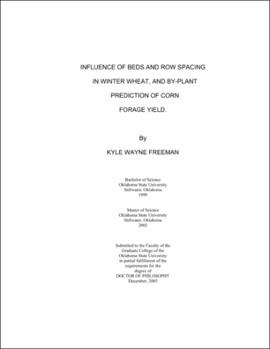| dc.contributor.advisor | Raun, William | |
| dc.contributor.author | Freeman, Kyle Wayne | |
| dc.date.accessioned | 2013-12-10T18:04:34Z | |
| dc.date.available | 2013-12-10T18:04:34Z | |
| dc.date.issued | 2005-12 | |
| dc.identifier.uri | https://hdl.handle.net/11244/7728 | |
| dc.description.abstract | Scope and Method of Study: For chapter one, Hard red winter wheat (Triticum aestivum L.) experiments were conducted to evaluate varieties, N rate, and row spacing in bedded and conventional planting systems. A factorial arrangement of treatments with 2 varieties ('2174', Jagalene), 2 N rates (0, 100), and 3 row spacings (6 & 15 cm with skipped rows, and 6 cm solid stand) were placed in the conventional planting system, while the bedded system consisted of 2 varieties, 2 N rates, and 2 row spacings. Corn (Zea mays L.) experiments were conducted to evaluate if spectral reflectance and plant height measurements could predict corn forage biomass on a by-plant basis. The normalized difference vegetation index (NDVI) for each plant was collected with a GreenSeeker Hand Held optical reflectance sensor mounted to a bicycle with a shaft encoding device to record distance. Plant height measurements were collected by extending the last collar leaf of each plant upward and recording the distance from the tip of the leaf to the ground. | |
| dc.description.abstract | Findings and Conclusions: For chapter one, in 4 out of 6 years grain yields in the bed planting systems were similar to grain yield of the conventional planting system. Grain yield was not affected by row spacing. At Hennessey, no consistent differences were recorded among varieties and N rate; however LCB posted significant differences across the 3 years of the study. There was a significant trend for increased grain yield with the solid stand compared to the skipped row treatments. This study showed a trend for increased grain yield of the bed system over the flat when cropping systems call for skipped row configurations that accommodate controlled traffic lane or relay cropping. For chapter two, over sites and years by-plant forage yield was predicted using the multiple of NDVI and plant height from growth stages ranging from V8 to V10. The combined use of plant height and NDVI better predicted forage yield than when using either plant height or NDVI alone. These results are encouraging since the ideal time to top-dress fertilize corn is at the V8-V10 growth stages and when biomass can be accurately predicted. | |
| dc.format | application/pdf | |
| dc.language | en_US | |
| dc.rights | Copyright is held by the author who has granted the Oklahoma State University Library the non-exclusive right to share this material in its institutional repository. Contact Digital Library Services at lib-dls@okstate.edu or 405-744-9161 for the permission policy on the use, reproduction or distribution of this material. | |
| dc.title | Influence of beds and row spacing in winter wheat, and by-plant prediction of corn forage yield | |
| dc.contributor.committeeMember | Klatt, A. R. | |
| dc.contributor.committeeMember | Johnson, Gordon V. | |
| dc.contributor.committeeMember | Solie, John B. | |
| osu.filename | Freeman_okstate_0664D_1641 | |
| osu.accesstype | Open Access | |
| dc.type.genre | Dissertation | |
| dc.type.material | Text | |
| thesis.degree.discipline | Plant and Soil Sciences | |
| thesis.degree.grantor | Oklahoma State University | |
